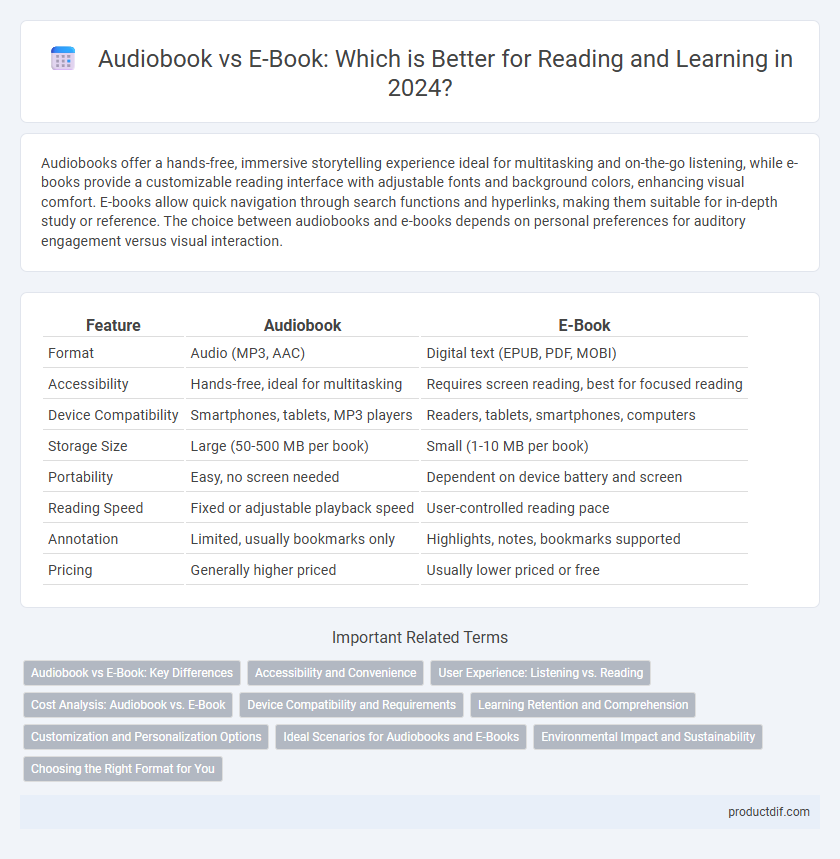Audiobooks offer a hands-free, immersive storytelling experience ideal for multitasking and on-the-go listening, while e-books provide a customizable reading interface with adjustable fonts and background colors, enhancing visual comfort. E-books allow quick navigation through search functions and hyperlinks, making them suitable for in-depth study or reference. The choice between audiobooks and e-books depends on personal preferences for auditory engagement versus visual interaction.
Table of Comparison
| Feature | Audiobook | E-Book |
|---|---|---|
| Format | Audio (MP3, AAC) | Digital text (EPUB, PDF, MOBI) |
| Accessibility | Hands-free, ideal for multitasking | Requires screen reading, best for focused reading |
| Device Compatibility | Smartphones, tablets, MP3 players | Readers, tablets, smartphones, computers |
| Storage Size | Large (50-500 MB per book) | Small (1-10 MB per book) |
| Portability | Easy, no screen needed | Dependent on device battery and screen |
| Reading Speed | Fixed or adjustable playback speed | User-controlled reading pace |
| Annotation | Limited, usually bookmarks only | Highlights, notes, bookmarks supported |
| Pricing | Generally higher priced | Usually lower priced or free |
Audiobook vs E-Book: Key Differences
Audiobooks offer a hands-free listening experience, enabling multitasking and accessibility for visually impaired users, while e-books provide customizable text formats for personalized reading. Audiobooks require audio playback devices or apps, whereas e-books need e-readers or compatible digital devices with screen displays. The consumption time varies, with audiobooks matching the narrator's pace and e-books allowing readers to skim or read at their own speed.
Accessibility and Convenience
Audiobooks offer greater accessibility for individuals with visual impairments and those who prefer multitasking, allowing users to listen while commuting or exercising. E-books provide convenience through adjustable text size, search functions, and portability on various devices, catering to readers who favor visual engagement. Both formats enhance accessibility and convenience by accommodating diverse reading preferences and lifestyles.
User Experience: Listening vs. Reading
Audiobooks provide a hands-free experience ideal for multitasking, enhancing accessibility for users with visual impairments or busy lifestyles. E-books offer customizable reading settings like adjustable font sizes, backlighting, and annotation tools, catering to varied reading preferences. The choice between listening and reading hinges on individual learning styles, situational convenience, and sensory engagement preferences.
Cost Analysis: Audiobook vs. E-Book
Audiobooks typically cost more than e-books due to production expenses including narration and sound editing, with average prices ranging from $15 to $30 per title compared to $5 to $15 for e-books. Subscription services like Audible offer cost-effective options for frequent listeners but still may exceed the price of purchasing e-books individually or through platforms like Kindle or Apple Books. The long-term cost efficiency depends on user reading habits, with e-books providing more affordable ownership and audiobooks offering enhanced convenience and accessibility at a higher price point.
Device Compatibility and Requirements
Audiobooks offer broad device compatibility, playing seamlessly on smartphones, tablets, smart speakers, and dedicated audiobook players without the need for specific software. E-books require compatible e-readers or apps such as Kindle, Nook, or Apple Books, often demanding screen size and format support like EPUB or MOBI files. Both formats depend on sufficient storage space and internet connectivity for downloading, but audiobooks may consume more data due to larger file sizes.
Learning Retention and Comprehension
Audiobooks enhance learning retention by engaging auditory memory through narration, making them ideal for multitasking or auditory learners. E-books support comprehension through the ability to highlight, annotate, and re-read at one's own pace, catering to visual learners. Research indicates blended use of audiobooks and e-books maximizes cognitive processing and reinforces information retention.
Customization and Personalization Options
Audiobooks offer customizable playback speed, sleep timers, and voice options, enhancing user experience through auditory personalization. E-books provide extensive personalization features such as adjustable font size, background color, and margin settings, allowing readers to tailor visual comfort. Both formats support bookmarks and notes, but e-books excel in customizable reading layouts while audiobooks emphasize adaptive listening preferences.
Ideal Scenarios for Audiobooks and E-Books
Audiobooks excel in scenarios where multitasking is essential, such as commuting, exercising, or performing household chores, allowing users to consume literature hands-free. E-books are ideal for detailed study, note-taking, and quick reference, benefiting readers who prefer visual engagement and easy navigation of text. Both formats cater to different needs: audiobooks enhance accessibility and convenience, while e-books support focused reading and annotation.
Environmental Impact and Sustainability
Audiobooks reduce paper consumption and deforestation by eliminating the need for physical books, contributing to a smaller carbon footprint compared to traditional print media. E-books also minimize environmental impact by requiring no physical materials and enabling users to store thousands of titles on a single device, thus lowering resource use and waste generation. However, both formats depend on electronic devices and energy consumption, highlighting the importance of sustainable tech practices and renewable energy sources to maximize their environmental benefits.
Choosing the Right Format for You
Audiobooks provide hands-free convenience and enhance multitasking for busy individuals, while e-books offer customizable reading experiences with adjustable fonts and lighting for eye comfort. Assessing your lifestyle, reading habits, and sensory preferences will help determine which format suits you best. Consider factors like time availability, learning style, and accessibility to maximize your reading enjoyment and retention.
Audiobook vs E-Book Infographic

 productdif.com
productdif.com